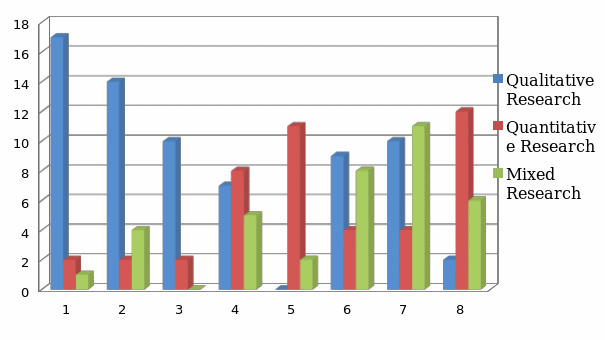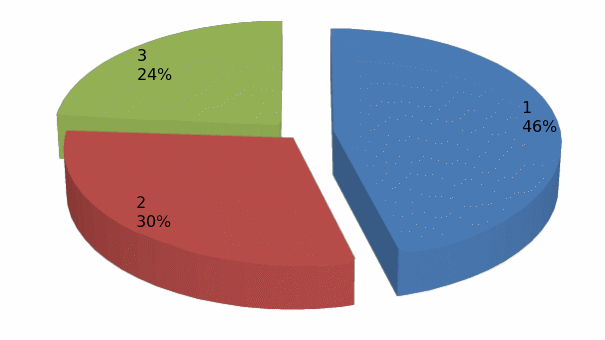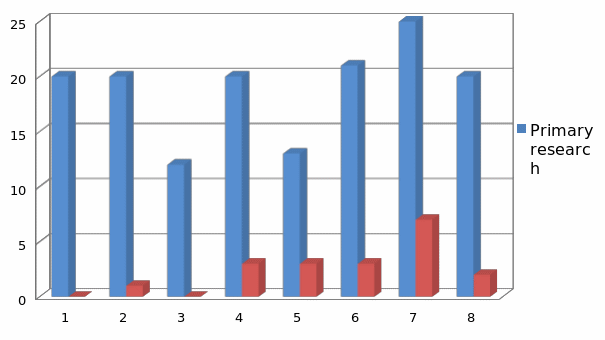Introduction
Research in Applied Linguistics and Discourse Studies (ALDS) is often focused on describing inter-language systems, cognitive mechanisms accounting for the inter-language systems, examination of social, affective as well as neurobiological systems which impact the development of the second language (Bryan, 1988). Research is also used to evaluate the impact of the instruction process on content delivery. This is in addition to the comparison of native and non-native linguistic systems and how speakers applied them to natural discourse among others. In the recent past, researchers have been keen on establishing the best research techniques that can help best evaluate the aforementioned areas as well as other areas of interest. Benson evaluates the use of qualitative research in the evaluation of foreign and second language teaching. His research puts lots of emphasis on the role that qualitative research plays in studying various aspects of language delivery to students (Benson et al., 2009). As mentioned in his research, he pre-supposes that over the decade through his research evaluates journals; qualitative research has risen to occupy an even important position in applied linguistics and discourse studies. A presumption of which, he goes further to prove through a series of well-elaborated research steps. Despite the stepwise and careful structure of his, research Benson fails to some key areas which would have further refined his findings.
Research gaps
It is not unusual for research papers to have some gaps in their findings. In reality, it is almost impossible to have perfect research papers that evaluate all aspects of the study subject. Likewise, Benson’s paper has some gaps which will guide the direction of the current research. Firstly the research ignores the impact of quantitative research methods and instead focuses purely on qualitative methods. Even then it fails to provide a clear distinction between qualitative, quantitative, and mixed research approaches (Bryan, 1988). Instead, it includes mixed research approaches as qualitative (Benson et al., 2009). It is important to acknowledge that such inclusion could easily impair the findings of the research. Additionally, Benson’s research purely focuses on major journals in engaging teaching and learning and hence fails to capture discourse analysis and JSWL. The research is also based on old data which may not reflect the current trends in applied linguistics research. These gaps formed the basis for the formulation of this paper’s research questions.
Research questions
This paper was guided by the following research questions:
- What are the research trends in Applied Linguistics and Discourse Studies (ALDS) regarding quantitative, qualitative, and mixed-method research?
- Do the results of this study support or refute Benson et al.’s (2009) findings?
- How does the use of primary research and secondary research relate to research in Applied Linguistics and Discourse Studies?
- What other research methods are employed in researches on Applied Linguistics and Discourse Studies?
Methodology
The full class of 2010 linguistic students participated in the development of this research. Their role involved the evaluation and classification of journals articles touching on applied linguistics and discourse studies. The participants were charged with the responsibility of distinguishing between the various research paradigms adopted by the journal articles. However, this could only be possible once the appropriate journals were promptly identified. Several steps, therefore, dictated the research process. These included:
Identification of appropriate research journals
Unlike Benson’s article which focused on learning and teaching journals (Benson et al., 2009), this research broadened to include discourse analysis and JSWL. In general, this stage involved the identification of journals with content on applied linguistics and discourse analysis. Further, noting that such journals would be enormous in number, the selection of the journals was limited to those which some level of global endorsement. Unlike, Benson’s study, the articles used for this research were purely based on 2009 -2010 journals. This made the research more representative of the current scenario as compared to Benson’s. The following articles were chosen for this purpose:
- Discourse Studies
- CMLJ – The Canadian Modern Language Journal
- Journal of Second Language Writing
- TESOL Quarterly
- Studies in Second Language Acquisition
- Applied Linguistics
- Modern Language Journal
- Language Learning
Identification of the research methods employed
Other than the two common research paradigms often employed, the study further classified the articles based on the sources of data used (Borg, 2002). This involved classifying them as either based on primary research or secondary research. This was in addition to classifying the same articles as either based on quantitative or qualitative research.
Collection of statistical data
The number of articles in each classification was then counted and the results tabulated.
Data analysis and interpretation
With the help of excel, the data collected was used to generate a series of bar graphs which formed the basis for analysis and responding to the earlier stated research questions. The graphs are used to compare the number of quantitative approaches used against the number of qualitative approaches. Additionally, the data assists in the comparison of primary research against secondary research in terms of numbers.
Results were displayed in form of tables and pie-charts shown below:

Where the number labeling on the horizontal axis represents the following:
- Discourse Studies
- CMLJ
- Journal of Second Language Writing
- TESOL Quarterly
- SSLA
- Applied Linguistics
- MLJ
- Language Learning
The bar graph reflects the findings of the qualitative, quantitative and mixed research distribution in applied linguistics and statistics. While some record high number of qualitative research prints, others record relatively low numbers. In general, no research approach show predominance over the other as the trend show a shift in distribution from one journal to another.
The totals across the journals are as shown by the pie chart below:

The pie chart gives a generalized statistics outcome of research trends with regard to qualitative, quantitative and mixed research approaches. Qualitative research claims a commanding share of generalized appearance across the journals with 46%.Quantitative and mixed methods trail behind with 30 and 24% respectively.
Comparing primary research usage and secondary research usage yields the following bar graph.

Where
- Discourse Studies
- CMLJ
- Journal of Second Language Writing
- TESOL Quarterly
- SSLA
- Applied Linguistics
- MLJ
- Language Learning
The bar graph displays a total dominance of primary research usage over secondary research. Secondary research use is relatively limited across all the journals.
The descriptive statistics table gives a more detailed view of the researches findings. Other than the forms of articles used in applied linguistic and discourse studies mentioned earlier, the study reveals that there are other forms commonly used though are rarely mentioned. These include letters, editorials, reports, and review. Another form rarely mentioned was author defined approaches to research. Surprisingly, Reviews recorded very high number of appearances in journals with one instance recording a maximum of 29 appearances and the overall count exceeding all forms of articles. Reviews also record the highest mean, followed by primary research and qualitative research.
Discussion
The researches findings successfully answer earlier stated research questions. Firstly, it is important to mention that the trends indicate that qualitative researches use has over the years grown in number. From the results obtained, it is evident that large portion of researcher prefer to use qualitative. Figure 2 shows that in total 46% of the researches evaluated, qualitative research methods were used. This is however contributed to by the large percentages recorded in Discourse Studies, CMLJ, SSLA and the Journal of Second Language Writing where a large portion of the results are based on qualitative research. The same cannot be said of the other journals where a relatively low percentage of qualitative approach usage is employed. These findings reveals that researchers are currently adopting use of all quantitative, qualitative and mixed research methods as deemed appropriate unlike the earlier assumption that quantitative research was the dominant choice.
In terms of primary versus secondary research usage, primary research remains a largely dominant approach used in research. Figure 3 reflects a complete dominance of primary research usage across all the journals used. This is confirmed by the relatively high amount of researches adopting the use of primary research as compared to secondary research. All the journals used in the study record high use of primary research. It can be conclusively said that primary research is more favored as compared to secondary research in the field of applied linguistics and discourse analysis.
In general it is important to mention that while the research outcomes conforms Benson’s findings that use of qualitative research has gained popularity over time, it goes further to establish the relation between primary research usage in comparison to secondary usage. Additionally, it reflects a number of other research techniques used by researchers in applied linguistic and discourse studies. These include letters, editorials, reports and reviews. Author defined methods are also gaining popularity among various researchers. Reviews however, seem to be gaining popularity at a rate higher than the other techniques.
Conclusion
In conclusion, it is important to mention that while the research confirms Benson’s findings that the use of qualitative research is growing in popularity, it goes further to highlight and the other forms of research too are growing in popularity. Unlike, quantitative research whose usage seems to have decline if the common assumption of its popularity is to be employed, reviews seem to be gaining significant popularity. This is best illustrated by the large mean it receives.
However, it is important to mention that the research too had some shortcomings which future researches need to overcome in order to produce more conclusive results. Firstly, the journals covered were mainly based on 2010. As such, these may only represent the case of 2010 and not the overall emerging trends. Additionally, the journals covered were few in number and as observed, they displayed different results when handled independently more so with respect to qualitative, quantitative and mixed research approaches. A large sample could have therefore potentially affected the outcomes of the results. Future researches should therefore attempt to bridge these shortcomings.
References
Benson, P. et al. (2009). Qualitative research in language and teaching Journals, 1997-2006.The Modern Language Journal, i, 79- 90.
Borg, R. W. (2002). Educational research: An Introduction: New York: Longman.
Bryan, A. (1988). Quantity and Quality in Social Research. London: Routledge.